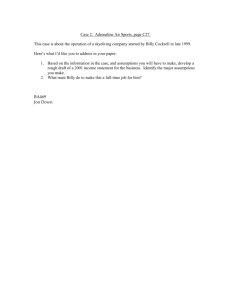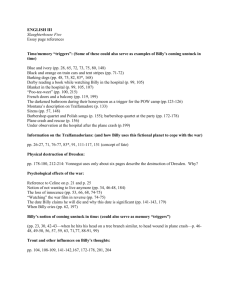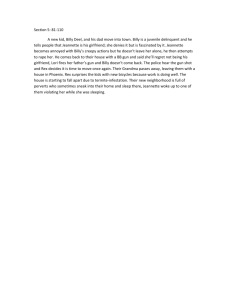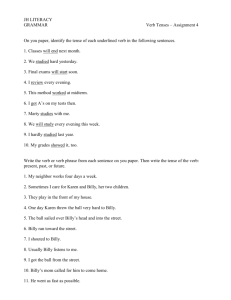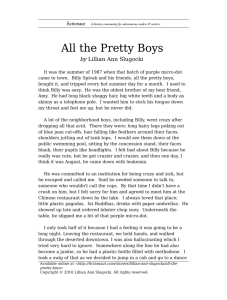Landham v. Lewis Galoob Toys, Inc.
advertisement
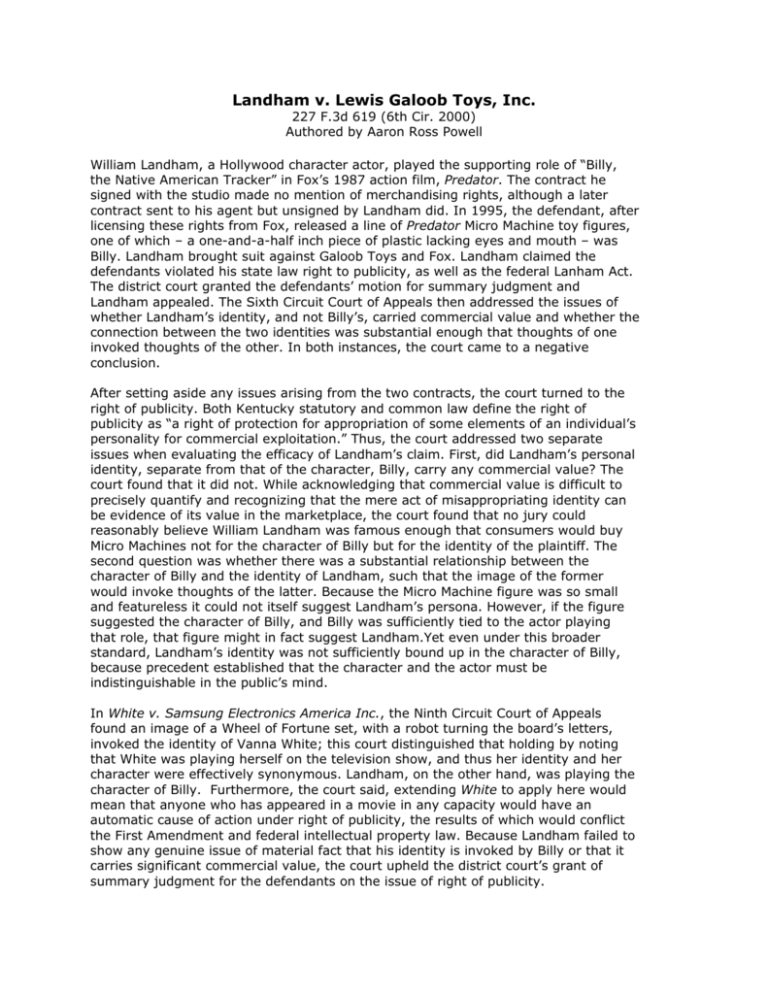
Landham v. Lewis Galoob Toys, Inc. 227 F.3d 619 (6th Cir. 2000) Authored by Aaron Ross Powell William Landham, a Hollywood character actor, played the supporting role of “Billy, the Native American Tracker” in Fox’s 1987 action film, Predator. The contract he signed with the studio made no mention of merchandising rights, although a later contract sent to his agent but unsigned by Landham did. In 1995, the defendant, after licensing these rights from Fox, released a line of Predator Micro Machine toy figures, one of which – a one-and-a-half inch piece of plastic lacking eyes and mouth – was Billy. Landham brought suit against Galoob Toys and Fox. Landham claimed the defendants violated his state law right to publicity, as well as the federal Lanham Act. The district court granted the defendants’ motion for summary judgment and Landham appealed. The Sixth Circuit Court of Appeals then addressed the issues of whether Landham’s identity, and not Billy’s, carried commercial value and whether the connection between the two identities was substantial enough that thoughts of one invoked thoughts of the other. In both instances, the court came to a negative conclusion. After setting aside any issues arising from the two contracts, the court turned to the right of publicity. Both Kentucky statutory and common law define the right of publicity as “a right of protection for appropriation of some elements of an individual’s personality for commercial exploitation.” Thus, the court addressed two separate issues when evaluating the efficacy of Landham’s claim. First, did Landham’s personal identity, separate from that of the character, Billy, carry any commercial value? The court found that it did not. While acknowledging that commercial value is difficult to precisely quantify and recognizing that the mere act of misappropriating identity can be evidence of its value in the marketplace, the court found that no jury could reasonably believe William Landham was famous enough that consumers would buy Micro Machines not for the character of Billy but for the identity of the plaintiff. The second question was whether there was a substantial relationship between the character of Billy and the identity of Landham, such that the image of the former would invoke thoughts of the latter. Because the Micro Machine figure was so small and featureless it could not itself suggest Landham’s persona. However, if the figure suggested the character of Billy, and Billy was sufficiently tied to the actor playing that role, that figure might in fact suggest Landham.Yet even under this broader standard, Landham’s identity was not sufficiently bound up in the character of Billy, because precedent established that the character and the actor must be indistinguishable in the public’s mind. In White v. Samsung Electronics America Inc., the Ninth Circuit Court of Appeals found an image of a Wheel of Fortune set, with a robot turning the board’s letters, invoked the identity of Vanna White; this court distinguished that holding by noting that White was playing herself on the television show, and thus her identity and her character were effectively synonymous. Landham, on the other hand, was playing the character of Billy. Furthermore, the court said, extending White to apply here would mean that anyone who has appeared in a movie in any capacity would have an automatic cause of action under right of publicity, the results of which would conflict the First Amendment and federal intellectual property law. Because Landham failed to show any genuine issue of material fact that his identity is invoked by Billy or that it carries significant commercial value, the court upheld the district court’s grant of summary judgment for the defendants on the issue of right of publicity. The court then turned to Landham’s claim that his trademark rights under the Lanham Act were violated by Galoob. Landham alleged that his rights were violated when the toy company used his image, creating what amounted to false endorsement. The public, he argued, would mistakenly believe, upon seeing the Billy Micro Machine, that Landham had endorsed the figure. To address this claim, the court set out the eight factor test for determining the likelihood of confusion. The factors are: (1) the strength of the plaintiff’s mark, (2) the relatedness of the goods, (3) the similarity of the marks, (4) evidence of actual confusion, (5) the marketing channels used, (6) the likely degree to which a purchaser would care about the perceived endorsement, (7) the defendant’s intent in selecting the mark, and (8) the likelihood of future expansion of the product lines. Using these eight factors as guidelines, the court found confusion unlikely given that the bulk of Landham’s film work had been for an adult audience and the Micro Machines were marketed towards children. Thus, the purchasers of the Micro Machines probably would have no idea who William Landham was. For this reason, as well as the ones given for rejecting the right of publicity claim, the court upheld the district court’s grant of summary judgment.
